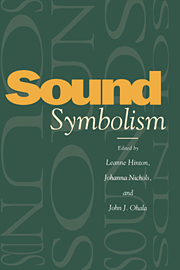Book contents
- Frontmatter
- Contents
- List of contributors
- 1 Introduction: Sound-symbolic processes
- PART I Native American languages north of Mexico
- PART II Native languages of Latin America
- PART III Asia
- PART IV Australia and Africa
- PART V Europe
- PART VI English
- 18 Phonosyntactics
- 19 Aural images
- 20 Inanimate imitatives in English
- PART VII The biological bases of sound symbolism
- Index
20 - Inanimate imitatives in English
Published online by Cambridge University Press: 04 August 2010
- Frontmatter
- Contents
- List of contributors
- 1 Introduction: Sound-symbolic processes
- PART I Native American languages north of Mexico
- PART II Native languages of Latin America
- PART III Asia
- PART IV Australia and Africa
- PART V Europe
- PART VI English
- 18 Phonosyntactics
- 19 Aural images
- 20 Inanimate imitatives in English
- PART VII The biological bases of sound symbolism
- Index
Summary
Introduction
There is in English an indistinctly delineated class of words described variously as onomatopoeic, echoic, and imitative. As used here, an imitative is a word based on an approximation of some non-linguistic sound but adapted to the phonemic system of the language. If the modeled sound is one produced vocally by an animate creature – human, mammal, bird – the adapted form, as a working procedure, is classified as an animate imitative (abbreviated AI); if the sound is emitted by an inanimate object (although often through manipulation by some animate creature) then it is an inanimate imitative (abbreviated II). A third related class, concerned mainly with the expression of emotional states and attitudes, is the exclamation (abbreviated El for exclamatory interjection). In certain of their syntactically detached uses, dictionaries refer to all three of these semantic classes as interjections.
Sources of data
Comic strips. Examples of IIs, AIs, and EIs have been systematically clipped from comic strips on a daily basis, out of from one to three different newspapers, over the period 1978–1990. What is found from these sources is a mixture of words in different stages of acceptance: idiosyncratic innovations used only by their individual creators; innovations whose use has spread to several comic strips; forms which may be common in colloquial speech but which are not in standard dictionaries; and standard words contained in standard dictionaries. The meanings of these comic-strip occurrences have been inferred from the situations in which they are pictured.
- Type
- Chapter
- Information
- Sound Symbolism , pp. 293 - 306Publisher: Cambridge University PressPrint publication year: 1995
- 6
- Cited by



